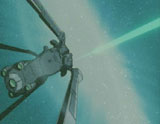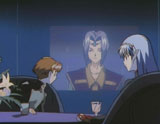

Quick Links:
Crest of the Stars, Volume 2: The Politics of War
In the first volume of Crest of the Stars, a fairly unconventional take on the space opera genre was presented, not so much as a result of a wildly original plot or terribly unique characters, but rather thanks to a strong focus on character development, as well as the interaction of the story's two leading characters, Jinto and Lafiel, and the growth of their relationship. While this focus paid off as a captivating, character driven introduction to the series, the pacing for those initial episodes suffered as a result, leaving action fans with an almost completely unquenched thirst for intergalactic warfare. Crest of the Stars' second volume wastes no time in making up for this initial lack of excitement, however, and does so with a grand sense of drama and style.
Picking up where the first volume left off, as an overwhelming attack on the Abh patrol ship Gosroth at the hands of the United Mankind seems imminent, an engaging sense of tension spills forth from every scene - a sense of tension and drama that takes center stage in lieu of over the top action to wonderful effect. Lafiel's emotional protest at the prospect of abandoning her post before the battle to escort Jinto to safety, coupled with her subsequent dejectedness, points to there being more than a mere sense of duty behind her strong desire to stay aboard, and this suspicion is borne out before the episode's end via a revelation, albeit a rather expected one, about her character. As the scene shifts back and forth between the edginess of approaching battle and the calm, sullen atmosphere of Jinto and Lafiel's escape shuttle, the contrasting feel of each setting becomes increasingly apparent, adding to the impact of each scene. Both the dialogue between Jinto and Lafiel as they make their escape, as well as the ensuing battle they left behind become increasingly gripping and satisfying as the encounter plays out, giving a sense of dramatic depth to what might otherwise seems like an episode long fight scene. The Battle Of Gosroth is an episode that manages to elevate the charming and entertaining, but otherwise unspectacular series to a whole new level with its mix of anxious drama; continued character development, offering further insight into the Abh mindset; finely choreographed and superbly executed action scenes; and an artistic, intriguing style of direction that demands your attention and interest.
Following the intensity of The Battle Of Gosroth, we're served with a change of pace during the following two episodes; and a it's a welcome change of pace at that, allowing the audience time to catch their breath before continuing with the main thrust of the story. On route to the Abh imperial state of Sufugnoff to give warning of the approaching United Mankind attack fleet, Jinto and Lafiel stop at a refueling station in the Baron Febdash Territory, a little known noble house trying to make a name for itself. No sooner than they arrive, it becomes readily apparent that something is awry. While Lafiel is greeted with a level of reverence befitting an Abh princess, Jinto, in spite of his recent rise to noble rank in Abh society, is treated with palpable contempt. This play between the Baron's vassals and the newly arrived pair sheds some light on the extreme end of the relationship between the space faring Abh and the lowly Landers, and upon meeting the haughty, refined Baron Klowal, we discover the source of this extreme attitude - Klowal's resentment of Landers is explained more thoroughly before this side story comes to a close. In the face of the oncoming enemy force, Klowal has plans to turn Lafiel's arrival to his advantage, as well as to deal with Jinto's unsavory presence, seeing him as a mockery to the Abh nobility, and quickly begins his scheming to set these plans into motion by delaying their departure. Not being fooled by Klowal's polite, agreeable facade for even a minute, Lafiel takes on an attitude of ever increasing hostility with the Baron almost immediately, and the ensuing series of verbal attacks and parries casts a new light on the darker side of the Abh people.
It was unfortunate to see video quality issues having a negative impact on the otherwise strong plot and animation in the first volume, and thankfully, Bandai's made efforts to ensure the same doesn't happen again with subsequent Crest of the Stars discs, including this second volume. Video encoding was entrusted to a new mastering house, CINRAM / POP, and the results are nothing short of stunning. The fluid animation, beautiful character designs and lush use of color truly shine in the absence of video mastering issues. The sixth and seventh episodes do still tend to show signs of corner cutting animation techniques often found in TV series as a result of budget and time constraints, but episode five, The Battle Of Gosroth, goes a step above standard TV fare and boasts some absolutely beautiful animation. Considering the fifth episode also featured the most extensive and involving battle sequences seen in the series thus far, The Battle Of Gosroth made the extra effort poured into turning the animation quality up a notch particularly rewarding.
As far as music and audio is concerned, this second disc follows the same pattern set forth previously - very fitting, albeit rather subdued orchestration reigns, often going unnoticed, but still working on a subconscious level to help set the mood of the scenes it accompanies. The music in the fifth episode had a more stirring presence to it than the more calm musical accompaniment of the subsequent episodes, which fit the more action oriented thrust of that episode perfectly. The score is by no means spectacular, but as nicely orchestrated background music goes, it fits the tone of the show like a glove.
Just as the music followed a similar trend as set forth in the first volume, so did the dialogue and voice acting. The Japanese voice acting continued to flow well, the cast doing a good job conveying believable emotion in their lines, but unfortunately, the English dub didn't improve in the least - at least it didn't improve as far as I could tell during the short period I could bear listening to it. The English dub was as stiff and jarring as ever, bleeding much of the emotion and seriousness out of potentially engaging scenes. I said as much in my review of the first volume, but it's worth reiterating that watching Crest of the Stars with the original Japanese dialogue in lieu of the English dub comes highly recommended, even for dub fans.
The cover design is quite stylish, and the art is a bit of a step up from the first volume - a saluting Lafiel alludes to the more serious, dramatic edge of this volume over the lighthearted feel of the initial disc. Information on planar space and how it's harnessed to facilitate intergalactic travel is included on the insert, while information on Abh culture, as well as the close ties between the military and the nobility, is continued in the on disc extras. The other extra of note included with this volume is a textless ending, showcasing the beautiful illustrations found in the sequence and the moving vocal ballad The Lost Blue Sky. The menus retain a similar feel as the first volume, however, a few minor glitches are addressed to make navigation and audio track selection easier.
Overall, the second volume of Crest of the Stars stands as an improvement in a number of respects over the already entertaining first disc, both with regards to content, thanks to the more balanced pacing and the inclusion of beautifully realized battle scenes, as well as technical concerns, like the much improved video quality. Anyone that enjoyed the first volume will no doubt continue to enjoy the series, and even those that steered clear of the series due to its previous lack of action might want to reconsider that decision.
Video Quality: A Audio Quality: B Presentation: B Content: A Overall: B+



